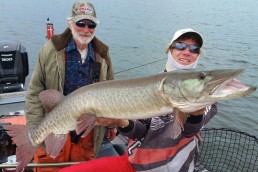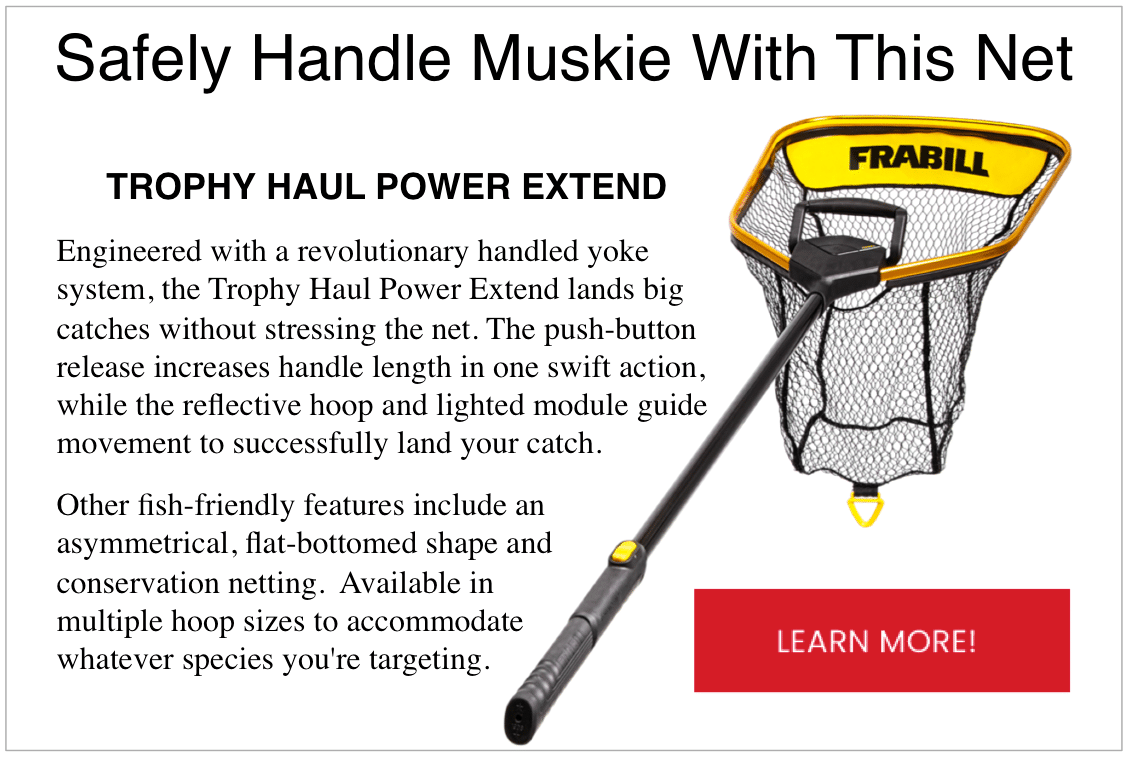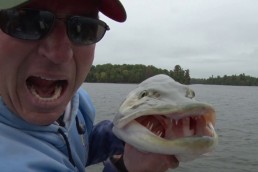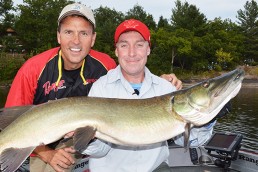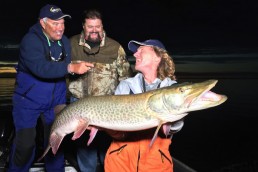Handle that Muskie to Fight Another Day
SHARE THIS POST
How to handle muskies
It’s an unfortunate fact, but I’ve come upon many a muskie, belly-up on the surface within some of the inland lakes near my home in Michigan’s northwestern Lower Peninsula. If the fish is freshly departed, I’ll grab my boat hook and roll the fish around to see if I can learn the cause of its demise.
More often than not, two unconcealed hints usually give away its cause of death: Torn lips and gums, indicating the fish had been caught, and fins and tail tinted bright-red, signifying a high level of stress.
Although the muskies caught in my neck of the woods grow enormous (the 58-pound state record, landed in October of 2012 was from here) their population is low. Michigan Department of Natural Resources surveys show a population of one fish per square mile in one of the most popular systems. To say just a single dead beast is distressing is an understatement.
But there’s also no doubting that landing such a large fish is one of the most exhilarating moments in any angler’s lifetime, whether muskies were the target or if the fish was an accidental catch. But there’s no more important time for anglers to calm down than once the fish is netted, making sure it’s safe from harm well before the high-fives begin.
Catching breath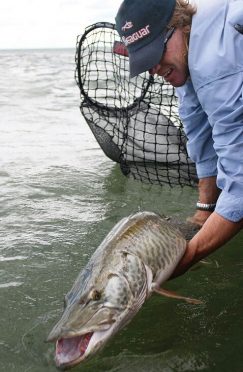
One of the most notable Esox anglers in America is Pete Maina. A resident of Hayward, Wisconsin, Maina is not only surrounded by waterways teaming with muskies and northern pike, but he also travels the country and Canada in search of trophy fish.
“Any fish losing its life when there is no need for it is a big deal,” says Maina. “It just isn’t necessary. And the possibility of a pike or muskie dying can be reduced a lot by just following a few simple steps.”
First off, Maina makes it clear he’s learned the most about releasing fish unharmed from the very mistakes he made early on in his career. And then there are those times when a fish literally fought itself to death, expiring before it was netted. Heart attack? Perhaps. But just the extreme stress of being hooked and landed can build up enough lactic acid to kill it. However, keeping fish out of the water too long for photos and TV spots were one of the main things Maina admits was an avoidable lesson learned.
“It’s the fish’s face that breathes,” Maina maintains. “A fish’s head needs to be under the surface as much as possible. And I’m not just talking about for photos and the like, but while the fish is in the net, too.”
Oftentimes, in the excitement of the moment, anglers don’t realize the fish may be curled up in the net with its head out of the water. That’s detrimental if it takes several minutes before the anglers are ready to remove hooks. All this time not getting oxygen is really tough on a fish, especially when it is starved for oxygen after the battle.
Measuring up
Social media might be one of the worst things to ever happen to muskies when it comes to being released without harm. But it’s also a great way to voice concerns and get fellow anglers thinking about how they go about minimizing stress on the big fish.
The many photos we take of a trophy muskie or pike so that we can post them for all of our so-called friends to see can keep the fish’s head out of the water too long and suffocate it. And don’t even get folks started about horizontal fish holds versus vertical. Horizontal is easier on the fish. That said, Maina states he’d rather see someone hold a fish out of the water vertically for a quick three-second photograph than held out for three minutes to get the perfect horizontal shots. A big fish often will be vertical for a few seconds anyway as you prepare to get it into a horizontal position.
But a post by Maina on Facebook this fall really got die-hard muskie anglers commenting on proper fish handling, and that was on the use of bump boards within a boat to measure length.
Maina’s suggestion is to measure the fish in the net or cradle with either a tape measure or bump board—don’t bring the fish in and lay it on the floor of the boat. A lot of damage happens to a big fish as it flops around. Flopping can remove its protective slime and it can injure itself if it whacks its body against the floor, seats or equipment.
Are you enjoying this post?
You can be among the first to get the latest info on where to go, what to use and how to use it!
“I got hammered for that post,” says Maina. “But it’s all good because it really got people thinking. And that’s the important thing.”
Minnesota outdoor writer and avid muskie hunter Cory Schmidt suggests forgoing measuring a fish’s length altogether in favor of weighing it.
“Weighing a fish is the one true way of measuring a muskie’s size,” Schmidt states. “There can be a huge weight difference between two 52-inchers, for instance.”
Schmidt’s suggestion? Hook your scale to the net and weigh both. That way you never even have to touch the fish, and it’s only out of the water a few seconds. Once the fish is released, reweigh the net, and then subtract that from the total. Easy as that.
He adds that weighing fish shouldn’t be done in just any old muskie net. “You need to use a net with nice soft mesh and with a broad, flat bottom that supports the weight of the fish rather than contorting it in unnatural angles. Frabill’s Conservation Series is the one I rely on.
“Anglers in Europe have been weighing monster pike in nets or weigh sacks for decades. They always assure the net or weigh sack is wet to protect the slime layer. There’s a reason European pike anglers catch, weigh and release the same pike a dozen or more times throughout the fish’s lifetime. Careful handling, weighing and releasing works.”
Make a Boy Scout proud
Schmidt says anyone targeting muskies should be prepared, well before making the first cast. The net should be ready to go. Hook removers, heavy-gauge wire snippers, fish-handling gloves and the like need to be easily accessible. Every second counts to release a fish unharmed.
Being prepared means rigging with the right leaders, too. Maina uses Seaguar’s AbrazX Muskie/Pike Leaders exclusively as fluorocarbon leaders are much easier on fish than wire.
When trolling, for example, Maina uses up to 6 feet of 100-pound-test fluorocarbon leader attached to a main line of 80-pound-test braid. Muskies tend to roll, and the line inevitably wraps around the fish. Steel leaders remove the fish’s slime coating, or worse yet, scrape off scales and even slice into the fish’s skin. Fluorocarbon just slides right over the the skin.
Last but not least, even weather conditions can upset the health of a muskie or pike. Releasing a fish on calm days is a much less tense situation than when the water’s roiled.
Maina says big waves make it much harder for a muskie to get its equilibrium and it’s harder for anglers to be as agile. This means that when the wind’s howling you need to have your act together and be able to release that fish faster than ever.
Can do
Overall, releasing an muskie unharmed so that it can fight again boils down to just a few simple steps. Make sure your boat’s in order before fishing. Once hooked, get the fish in the net and keep it there with its head submerged. Remove or cut the hook and measure or weigh the fish without touching it. If photographs are necessary, take your pictures while the fish is in the water. If taking it out is a must, make it a quick, smooth procedure. MWO
David A. Rose is a writer, photographer and fishing guide who lives near Traverse City, Mich.
Now that you know safe handling methods, here is an article by Dan Basore about muskie fishing.
MWO
SHARE THIS POST
Did you enjoy this post?
You can be among the first to get the latest info on where to go, what to use and how to use it!
MWO
We believe being outdoors is good. With more than 1,000 articles each year, MidWest Outdoors magazine is all about sharing outdoor experiences with you—where to go, what to use and how to use it… whether you’re close to home or on that trip of a lifetime.
